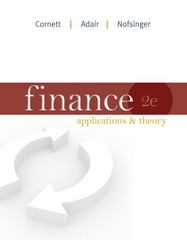Question
a) Assuming an imputation tax system, show the values for A, B, C and D below. Show all workings and attach a minus sign (-)
a) Assuming an imputation tax system, show the values for A, B, C and D below. Show all workings and attach a minus sign (-) to the value if it is a cash outflow. (4 marks)
| Marginal tax rate | 45% | 19% |
|---|---|---|
| Corporate level | ||
| Net Profit Before Tax | $3 | $3 |
| Corporate tax (30%) | -$0.90 | -$0.90 |
| Net Profit After Tax | $2.10 | $2.10 |
| Shareholder level | ||
| Cash dividends | $2.10 | $2.10 |
| Gross-up adjustment | ||
| Grossed-up dividends | A | A |
| Personal Tax | ||
| Franking credit | ||
| Tax payable or refund | B | C |
| Dividend after taxes | D |
b) ACM Corporation has one million shares outstanding selling at $10 each. It plans to repurchase 200,000 shares at the market price. What will its market capitalisation be after the repurchase? What will its share price be? (2.5 marks)
c) You, as an Australian resident, hold shares in FIN222 Ltd which you purchased 2 years ago for $30 per share. They are now selling for $37 per share. You have a marginal tax rate of 37% while the corporate tax rate is 30%. Under the imputation tax system, would you prefer to receive $7 special dividends or sell the shares and benefit from capital gains? Show all your workings. (4.5 marks)
d) Richmond Ltd has a cost of equity of 12% (calculated assuming a classical tax system), a pre-tax cost of debt of 4.5%, and is financed 60% with equity and 40% with debt. The corporate tax rate is 30%. What is this firms weighted average cost of capital assuming that investors can utilise 80% of the franking credits paid by the firm? (3 marks)
Step by Step Solution
There are 3 Steps involved in it
Step: 1

Get Instant Access to Expert-Tailored Solutions
See step-by-step solutions with expert insights and AI powered tools for academic success
Step: 2

Step: 3

Ace Your Homework with AI
Get the answers you need in no time with our AI-driven, step-by-step assistance
Get Started


